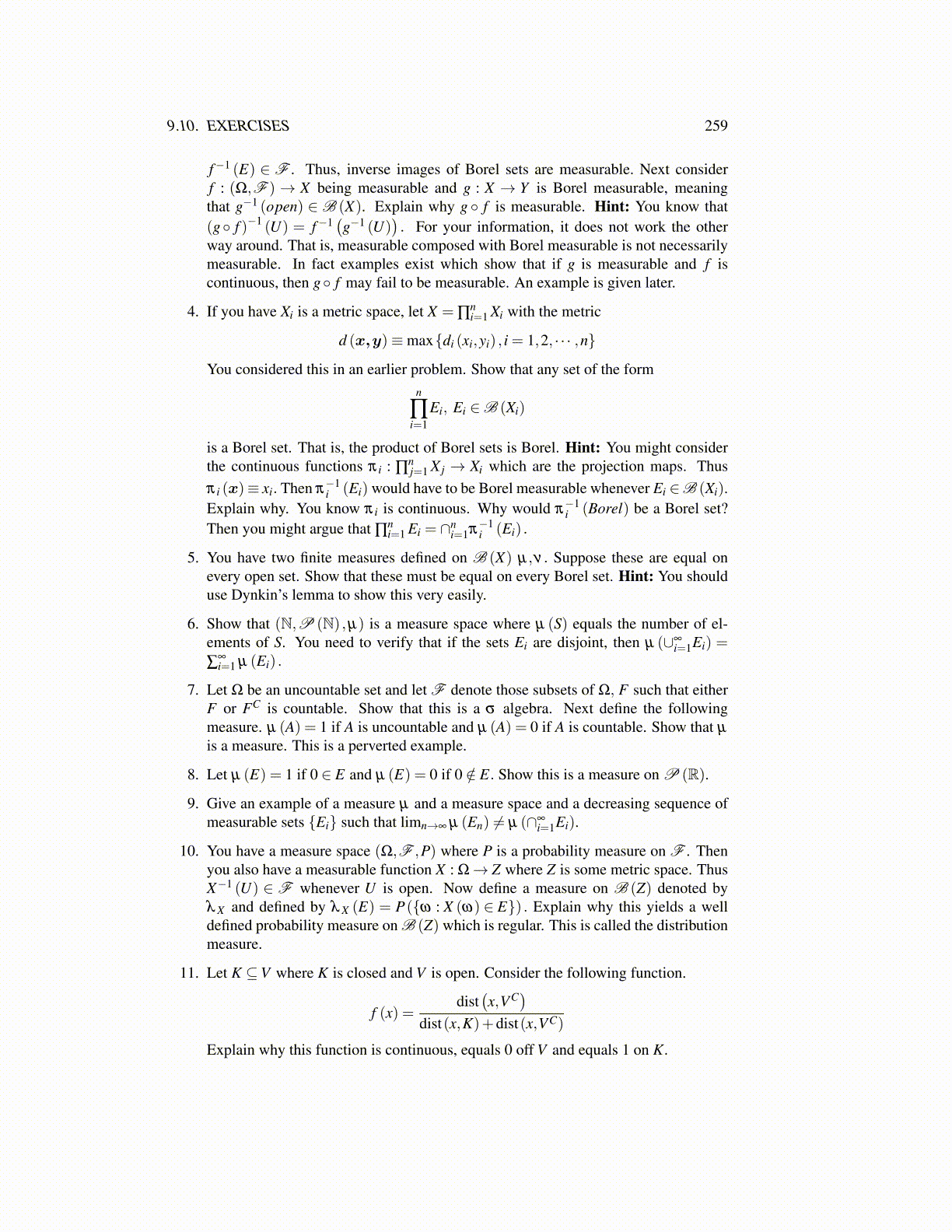
9.10. EXERCISES 259
f−1 (E) ∈ F . Thus, inverse images of Borel sets are measurable. Next considerf : (Ω,F ) → X being measurable and g : X → Y is Borel measurable, meaningthat g−1 (open) ∈ B (X). Explain why g ◦ f is measurable. Hint: You know that(g◦ f )−1 (U) = f−1
(g−1 (U)
). For your information, it does not work the other
way around. That is, measurable composed with Borel measurable is not necessarilymeasurable. In fact examples exist which show that if g is measurable and f iscontinuous, then g◦ f may fail to be measurable. An example is given later.
4. If you have Xi is a metric space, let X = ∏ni=1 Xi with the metric
d (x,y)≡max{di (xi,yi) , i = 1,2, · · · ,n}
You considered this in an earlier problem. Show that any set of the formn
∏i=1
Ei, Ei ∈B (Xi)
is a Borel set. That is, the product of Borel sets is Borel. Hint: You might considerthe continuous functions π i : ∏
nj=1 X j → Xi which are the projection maps. Thus
π i (x)≡ xi. Then π−1i (Ei) would have to be Borel measurable whenever Ei ∈B (Xi).
Explain why. You know π i is continuous. Why would π−1i (Borel) be a Borel set?
Then you might argue that ∏ni=1 Ei = ∩n
i=1π−1i (Ei) .
5. You have two finite measures defined on B (X) µ,ν . Suppose these are equal onevery open set. Show that these must be equal on every Borel set. Hint: You shoulduse Dynkin’s lemma to show this very easily.
6. Show that (N,P (N) ,µ) is a measure space where µ (S) equals the number of el-ements of S. You need to verify that if the sets Ei are disjoint, then µ (∪∞
i=1Ei) =
∑∞i=1 µ (Ei) .
7. Let Ω be an uncountable set and let F denote those subsets of Ω, F such that eitherF or FC is countable. Show that this is a σ algebra. Next define the followingmeasure. µ (A) = 1 if A is uncountable and µ (A) = 0 if A is countable. Show that µ
is a measure. This is a perverted example.
8. Let µ (E) = 1 if 0 ∈ E and µ (E) = 0 if 0 /∈ E. Show this is a measure on P (R).
9. Give an example of a measure µ and a measure space and a decreasing sequence ofmeasurable sets {Ei} such that limn→∞ µ (En) ̸= µ (∩∞
i=1Ei).
10. You have a measure space (Ω,F ,P) where P is a probability measure on F . Thenyou also have a measurable function X : Ω→ Z where Z is some metric space. ThusX−1 (U) ∈ F whenever U is open. Now define a measure on B (Z) denoted byλ X and defined by λ X (E) = P({ω : X (ω) ∈ E}) . Explain why this yields a welldefined probability measure on B (Z) which is regular. This is called the distributionmeasure.
11. Let K ⊆V where K is closed and V is open. Consider the following function.
f (x) =dist(x,VC
)dist(x,K)+dist(x,VC)
Explain why this function is continuous, equals 0 off V and equals 1 on K.